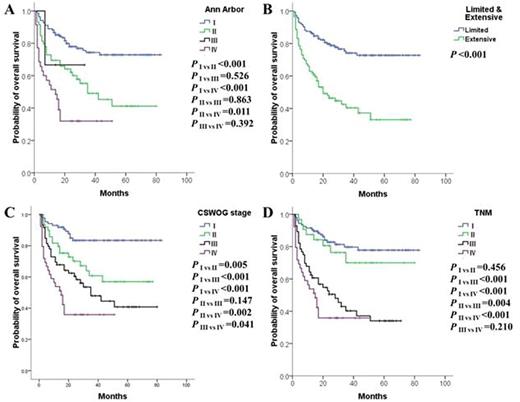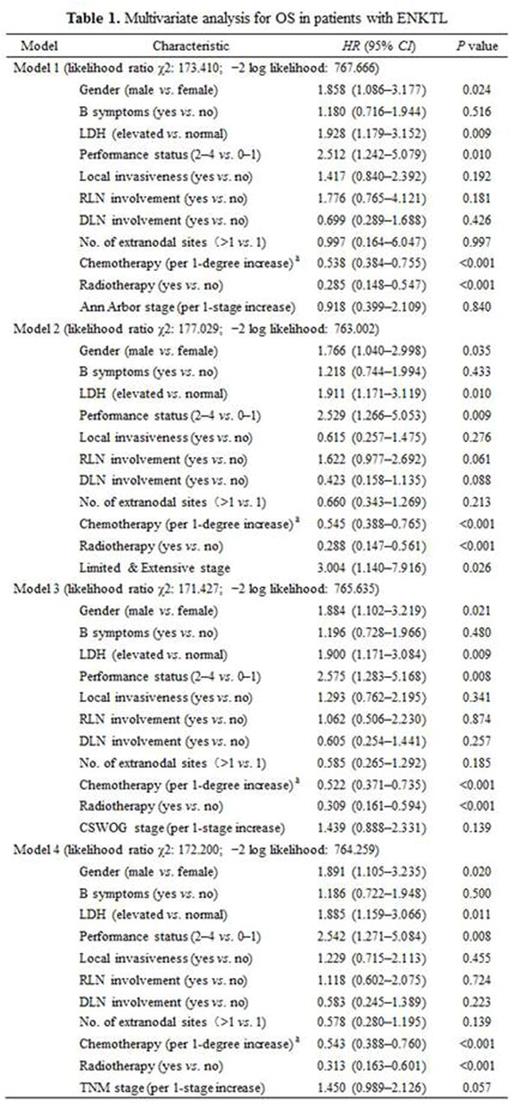Abstract
Introduction
The staging system for extranodal natural killer/T-cell lymphoma, nasal type (ENKTL) remains to be an open issue. The purpose of this retrospective study was to determine the performance of four staging systems for nasal ENKTL: Ann Arbor (AA) stage, limited & extensive stage, stage of Chinese Southwest Oncology Group (CSWOG) and Tumor-Node-Metastasis (TNM) stage.
Methods
This study was comprised of 233 patients with nasal ENTKL. The AA staging system was based on the Lugano modification of AA stage. The limited & extensive staging system was based on the AA stage, and the presence or absence of local tumor invasiveness: limited disease (AA stage I-II without LTI) and extensive disease (AA stage I-II with LTI or AA stage III-IV). The CSWOG staging system was described as follows: stage I, lesions confined within the upper aerodigestive tract without local invasiveness (paranasal sinuses, bony or skin invasion); stage II, localized disease with local invasiveness; stage III, localized disease with regional lymph node (cervical lymph node) involvement; and the others were stage IV. The TNM staging system was described by previous study (Yan et al. PLoS One, 2015). The 3-year overall survival (OS) rates were estimated using the Kaplan-Meier method, and survival curves were compared by the log-rank test. Multivariate analyses were performed using four separate COX models to assess the prognostic values of AA stage, limited & extensive stage, CSWOG stage and TNM stage, respectively, after adjusted for the effects of other covariates.
Results
After a median follow-up of 35.5 months, estimated 3-year OS rate was 61.3%. Multivariate analyses showed that limited & extensive stage, gender, performance status, lactate dehydrogenase (LDH), chemotherapy and radiotherapy were predictive of OS. The AA, CSWOG and TNM staging systems were not independent prognostic factors. Based these results, patients were stratified into four groups: low-risk limited disease (without risk factor), high-risk limited disease (with at least one risk factor: male, poor performance status, higher LDH), extensive disease with AA stage I-II and extensive disease with AA stage III-IV, for which the 3-year OS rates were 94.0%, 67.9%, 46.2% and 34.0%, respectively (P<0.050 in all pairwise comparisons).
Conclusions
The limited & extensive staging system is more suitable for nasal ENKTL than other staging systems. Risk stratification based on this system owns a good ability to discriminate the prognosis of ENKTL patients. Prospective multicenter studies are needed to further confirm these findings.
Keywords: Extranodal Lymphoma, NK-T Cells, Staging
Survival curves of 233 newly diagnosed patients with ENKTL according to each staging system.
Survival curves of 233 newly diagnosed patients with ENKTL according to each staging system.
Survival curves of 233 newly diagnosed patients with ENKTL according to risk stratification. Group 1, low-risk limited disease (without risk factor); Group 2, high-risk limited disease (with at least one risk factor: male, poor performance status, higher LDH); Group 3, extensive disease with AA stage I-II; and Group 4, extensive disease with AA stage III-IV.
Note: a Patients treated without chemotherapy, with non-asparaginase-based chemotherapy and with asparaginase-containing chemotherapy were assigned the value 1, 2 and 3, respectively. A larger value of likelihood ratio 2 and a smaller value of −2 log likelihood indicated a better model for predicting outcome. CSWOG, Chinese Southwest Oncology Group; DLN, distant lymph node; LDH, lactic dehydrogenase; RLN, regional lymph node; TNM, Tumor-Node-Metastasis.
Survival curves of 233 newly diagnosed patients with ENKTL according to risk stratification. Group 1, low-risk limited disease (without risk factor); Group 2, high-risk limited disease (with at least one risk factor: male, poor performance status, higher LDH); Group 3, extensive disease with AA stage I-II; and Group 4, extensive disease with AA stage III-IV.
Note: a Patients treated without chemotherapy, with non-asparaginase-based chemotherapy and with asparaginase-containing chemotherapy were assigned the value 1, 2 and 3, respectively. A larger value of likelihood ratio 2 and a smaller value of −2 log likelihood indicated a better model for predicting outcome. CSWOG, Chinese Southwest Oncology Group; DLN, distant lymph node; LDH, lactic dehydrogenase; RLN, regional lymph node; TNM, Tumor-Node-Metastasis.
No relevant conflicts of interest to declare.
Author notes
Asterisk with author names denotes non-ASH members.




This feature is available to Subscribers Only
Sign In or Create an Account Close Modal